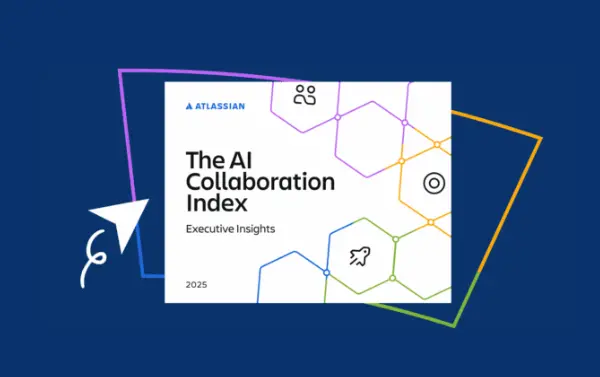If you’ve watched the enterprise AI gold rush of the past two years, you’ve seen the pattern: massive investments, breathless executive announcements, and promises of revolutionary transformation. Now comes the cold shower of reality, 96% of Fortune 1000 executives surveyed by Atlassian report that AI has failed to deliver meaningful ROI.
The numbers paint a compelling picture of cognitive dissonance in corporate America. While AI adoption has doubled in the past year and knowledge workers report being 33% more productive with an average daily time savings of 1.3 hours, these individual gains are vanishing before they reach the corporate bottom line.
Welcome to the great AI productivity paradox, where everyone’s working faster but nobody’s working smarter.
The Widening Perception Gap Between Floors
The Atlassian AI Collaboration Index: Executive Insights reveals a stunning disconnect between executive optimism and frontline reality. Upper management is 5.6 times more likely to believe AI dramatically improves problem-solving capabilities, while employees closer to actual work see the limitations more clearly.
This perception gap isn’t just philosophical, it’s creating strategic blind spots. When senior leaders believe AI is solving complex problems while frontline teams struggle with implementation friction, you get exactly the kind of ROI disconnect we’re witnessing.
Department by department, the experience varies wildly. Marketing and HR leaders are 2.3 times more likely than their IT counterparts to report meaningful business gains. Why? These non-technical departments can leverage AI to solve technical problems without needing deep expertise, while IT departments grapple with the messy realities of implementation, security, and integration.
The Illusion of Individual Productivity
Take a closer look at those “impressive” productivity numbers. Employees saving 1.3 hours daily sounds terrific until you realize most of that time is being wasted on AI experimentation, tool switching, and what one executive called “solving the same problem four times with four different AI assistants.”
The problem isn’t that AI isn’t powerful, it’s that we’re using it wrong. 37% of managers report their teams are already overwhelmed by AI use or wasting time, according to the research. Companies that focus exclusively on individual productivity are 16% less likely to achieve real innovation.
This creates a vicious cycle: pressure to show AI adoption leads to scattered implementation, which generates busywork metrics rather than strategic outcomes, which justifies continued investment in the wrong places.
The Training Illusion and Security Bottleneck
Nearly 70% of organizations now offer AI training, but Atlassian’s research suggests most of it is ineffective. The most impactful learning happens in smaller, active communities or hands-on workshops focused on solving specific business problems, not in corporate-wide “AI literacy” programs.
Meanwhile, security concerns continue to throttle meaningful ROI. Technology leaders were twice as likely as their peers to cite security and compliance as barriers to scaling AI. Marketing leaders, conversely, feel their organizations are overly cautious, most prefer consumer AI tools over enterprise platforms despite the obvious risks.
The Head of Digital at a Fortune 1000 financial services company perfectly captured the core challenge: “At this moment, AI doesn’t help collaboration between teams. That’s a big pain point. How can it actually make teams work better together?”
Where AI Actually Delivers Value
Despite the doom and gloom, some applications are showing promise. IT support automation was identified as both the most widely used and most effective AI application. MLOps (model development and deployment) also showed strong potential, though only 38% of technology teams currently use AI for this purpose.
Performance measurement and reporting emerged as the top-rated AI use case among marketing teams, though it remains underutilized. Content creation tools drew mixed reviews, while 82% of knowledge workers say AI is highly effective at creating content, only 59% of marketing leaders agreed, citing accuracy and compliance concerns in regulated industries.
The fundamental issue appears to be systemic rather than technological. As Atlassian notes, when companies focus purely on individual task automation without redesigning workflows and collaboration patterns, they’re essentially “paving the cow paths” of their existing inefficiencies.
The $98 Billion Question
The stakes are massive. Atlassian estimates that Fortune 500 companies could be wasting up to $98 billion annually by focusing exclusively on individual productivity rather than organizational transformation. That’s the cost of optimizing tasks rather than reinventing processes.
The Zinnov and ProHance study reinforces this finding, showing that despite 92% of Global Capability Centers piloting or scaling AI initiatives, over 70% lack the structured frameworks necessary to measure their impact effectively.
Most organizations are treating AI like just another software tool rather than a fundamental capability requiring new processes, skills, and measurement frameworks. They’re measuring adoption rates instead of business outcomes.
Breaking Through the ROI Wall
So how do we escape this trap? The research points to several critical shifts needed:
Stop Counting Tools, Start Measuring Outcomes
Only 4% of executives reported major improvements in organizational efficiency, innovation, or work quality. Yet companies continue to track AI success by usage metrics rather than business impact.
Fix the Incentive Structure
Here’s a telling statistic: when executive pay is linked to AI adoption, company-wide uptake doubles. Yet only 10% of organizations currently have such incentives in place. We’re measuring the wrong things and rewarding the wrong behaviors.
Bridge the Departmental Divide
The gap between IT’s security concerns and marketing’s desire for consumer-grade tools represents a fundamental coordination failure. Companies need to design systems where “security and compliance are the default option”, using sandbox environments and clear guardrails that enable rather than prevent innovation.
Redesign Work, Don’t Just Accelerate It
The most successful organizations approach AI as an opportunity to redesign workflows entirely. As one observer noted, “You can’t delegate what you don’t yet understand. Until we build systems that make our work with AI visible and testable, not just faster, the ROI will stay local to individuals and not scale to organizations.”
The Human-AI Collaboration Imperative
The future isn’t about replacing humans with AI, it’s about creating new collaboration models. Executives predict that critical thinking, judgment, emotional intelligence, leadership, and ethics will become the most valuable skills in the modern workplace.
As Atlassian Chief People Officer Avani Prabhakar noted, “The future of work is human-AI collaboration. Preparing for this future requires a cultural transformation alongside a technological one.”
The takeaway is stark: we’ve been asking the wrong question. Instead of “How can we adopt AI faster?” we should be asking “How can we redesign our organizations to leverage AI meaningfully?” Until we make that shift, the ROI crisis will continue, and the real revolution will remain perpetually just around the corner.



